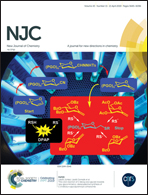Significant reduction in the optical band-gap and defect assisted magnetic response in Fe-doped anatase TiO2 nanocrystals as dilute magnetic semiconductors†
Abstract
Here, we have employed a low-temperature sol–gel route for developing functional semiconducting, Fe-doped anatase TiO2 nanocrystals. Detailed investigation of X-ray powder diffraction patterns confirms the anatase phase in Fe-doped TiO2, which is further verified by Raman analysis. The red shift and broadening associated with the Eg (1) mode in the Raman spectra reveal the substitution of Fe in place of Ti in TiO2. Selected area diffraction patterns obtained from transmission electron microscopy analysis indicate the crystalline nature of the sol–gel derived nanocrystals. A clear red shift is observed in the UV-visible spectra, which indicates the lowering of the band-gap as a result of Fe incorporation into the TiO2 lattice. The photoluminescence spectra give a clear idea regarding the defects associated with the system and the presence of Fe2+ and Fe3+ in Fe-doped TiO2 samples is confirmed from X-ray photoelectron spectra, leading to oxygen vacancy defects and bound magnetic polarons, which tailor the magnetic behavior in Fe-doped TiO2 at room temperature. The M–H measurements reveal that the magnetization increases with the Fe concentration and the variation of these magnetic properties is explained on the basis of the concept of bound magnetic polarons, which are in corroboration with the photoluminescence studies. Hence, the study on Fe-doped TiO2 nanocrystals could provide a new pathway in the field of spintronics and magneto optics by tuning the optical and magnetic properties through appropriate doping to accomplish these functional applications.



 Please wait while we load your content...
Please wait while we load your content...